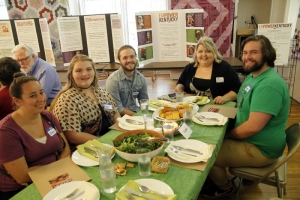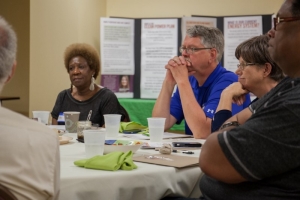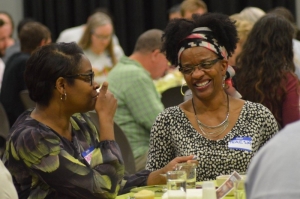Taking a Seat at the Table
Just imagine: your state is highly dependent on coal, a natural resource whose days seem numbered. Meanwhile, with the announcement of the Clean Power Plan, there is an exciting opportunity for your community to engage in a just transition to a cleaner, greener economy, and the state’s engagement in the planning process could have a positive impact for displaced coal workers and vulnerable ratepayers. But state leadership isn’t willing to move toward a brighter energy future. What do you do?
That’s the question that Kentuckians For The Commonwealth (KFTC), a 34-year-old, 10,000-member strong organization that works for a fair economy, a healthy environment, new safe energy, and an honest democracy, recently faced — and they’ve tackled it in an inclusive and visionary way.
Clean Power Plan
In August 2015, the Obama administration and the Environmental Protection Agency (EPA) announced the Clean Power Plan (CPP): “a historic and important step in reducing carbon pollution from power plants that takes real action on climate change.” The CPP requires each state to come up with its own plan to slash its greenhouse gas emissions by a certain percentage by 2030, or else accept a plan written by the EPA. In Kentucky — where almost all greenhouse gas emissions come from coal-fired power plants — the state needs to cut its emissions by 31 percent over the next 15 years.
But not every state is on board with the CPP — including Kentucky. In fact, Kentucky’s political representatives joined a group of roughly two dozen states to sue the EPA and prevent the CPP from being enacted. Lisa Abbott, the Empower Kentucky organizer at KFTC, notes that the political leadership in both major parties has treated the CPP as an attack on the state and an economic disaster. Given the political situation, she said, it became “clear that leadership would have to come from somewhere else.”
Empower Kentucky
Enter: Empower Kentucky, a new project of KFTC. When Kentucky’s leaders failed to do their job of writing the state’s CPP, KFTC realized that this was actually an opportunity to bring together residents from all over the state to share their vision for what Kentucky’s energy future could look like. As the Empower Kentucky website states,
The Empower Kentucky project invites Kentuckians from Paducah to Pikeville to share [their] vision for a bright energy future, one that is good for all of us. We will listen. We will learn from the experts and everyday people. Together we will develop homegrown solutions to create tens of thousands of new jobs for Kentuckians, protect our health, generate affordable and reliable power, and do our part to halt climate change.
Kentucky has almost all of its eggs in one basket when it comes to energy: coal, which has been declining for years. The state is facing a transition of its energy system, and while most leaders admit that coal is on the way out, there has been little state leadership to ensure that this transition is just, creative, sustainable, and beneficial to local residents.
KFTC members knew that nothing good was likely to come from Kentucky’s representatives on writing a CPP for the state — indeed, a bill was even introduced in the state legislature that would block the state from enforcing federal regulations for fossil fuel-fired power plants. State officials refused to write their own plan for the state, and KFTC realized that when the EPA ultimately stepped in with its own plan for Kentucky, those same officials could then blame the EPA for meddling in Kentucky’s energy policies and economy. And in February 2016, when the Supreme Court made the surprising decision to impose a stay on the implementation of the CPP, meaning that states were no longer required to move forward with developing their own plans, progress on the governmental level in Kentucky seemed totally stuck.
But KFTC members and leaders realized that if Kentucky’s political leaders refused to write a plan, KFTC could come up with its own, in collaboration with allies, partners, and Kentuckians from every corner of the state. The Empower Kentucky plan will be a real, actionable plan — vetted, modeled, and ready to be put into place. And the plan won’t just discuss how Kentucky can meet its benchmarks for cutting greenhouse gases: it will lay out a vision for the state’s bright energy future.
As Lisa spoke with people in other states about the public processes for their own state Clean Power Plans, she learned that they often saw real value in stepping back from the incremental, technical questions about each section of the CPP (though those questions are certainly important) and asking broader questions, like, “What direction would you like us to go in? What would your community need to benefit from a transition to clean energy?” With these sorts of questions in mind, the Empower Kentucky campaign was born.
A Seat at the Table
The primary purpose of the Empower Kentucky campaign is to “generate shared, aspirational political will in Kentucky for a new economy powered by clean energy,” says Burt Lauderdale, KFTC’s executive director. And while the details of the plan itself are important, so too is the planning process, which is happening all over the state to change the conversation, engage unlikely allies, and build momentum for change.
Dana Beasley Brown, KFTC’s chairperson, says that “it’s important for a healthy democracy for everyone impacted by an issue to have a seat at the table.” That’s why Empower Kentucky aims to have as many voices as possible in the room, ensuring that a wide-ranging set of local residents have a chance to share their vision and the ideas they have to achieve it.
In order for KFTC to attract broad participation from outside its own membership for the Empower Kentucky campaign, it developed a strategy of holding “community conversations” that would reflect the diversity of Kentucky’s communities and help Kentuckians understand that they all have a stake in Kentucky’s clean energy future. Throughout April and May 2016, KFTC hosted these public meetings — called “A Seat at the Table” — in each of Kentucky’s six congressional districts. The organization recruited table hosts from all across the community, each of whom were asked to find another seven folks to fill out their tables. About 75 percent of seats were held for recruitment by table hosts, and the rest of the seating was open to the general public; all tickets are free. Every single event was filled to capacity.
The Seat at the Table conversations were like a lively and invigorating combination of dinner theater and public hearing. Attendees shared a locally-sourced meal and had a chance to watch a theater performance or listen to local music rooted in the themes of just transition and community. They then had time at their tables for discussion, sharing ideas, and learning from one another about how they can achieve a new vision for Kentucky’s future. Lisa pointed out that “people are so hungry for something positive,” and that while they understand that there is real work to do in this long-term process of just transition, they are excited to talk about the things their communities want and need.
Dana, a table host for the Seat at the Table event in Bowling Green, spoke passionately about her experience at that April event. The audience of 100 people included a wide array of Kentuckians from all walks of life, including the CEO of a local utility company, a solar energy company owner, a director of Habitat for Humanity, a member of the Bowling Green Human Rights Commission, a representative of the local housing authority, professors, farmers, and members of coal-mining families who had lost relatives to black lung disease. Local students attended too, and one spoke eloquently about the need for paradigm shift in Kentucky to help move the state forward.
Dana pointed out that these Seat at the Table conversations were an experiment — since anyone could attend, KFTC didn’t know exactly how the conversations would turn out and what people would bring to the table. But the Bowling Green conversation, she said, “was such a special evening, with so many folks from so many walks of life coming together and sharing their relationship to energy, the vision they have for Kentucky, and the ideas we need to reach that vision.”
Overall, Dana said, the event was an “incredible evening for your soul.” It was wonderful for her to hear all the ideas from the diverse folks in the room who “all had hope for Kentucky and our energy future.” Indeed, she said, the event was “one of the most profound moments I’ve had in my decade in KFTC.”
What Comes Next?
Now that the Seat at the Table events have wrapped up, KFTC will work to compile all of the input from attendees and from its members and partners — all the dreams, wishes, and big ideas — and develop a draft Empower Kentucky report. Accompanied by a robust social media and digital communication strategy, this will be a comprehensive state plan aligned with just transition principles that meets — and perhaps exceeds — the carbon emission reduction targets for Kentucky as set by the EPA.
Then, this fall, KFTC plans to host an Empower Kentucky summit that will bring together Kentuckians to learn about the report framework in an atmosphere full of ideas, stories, and arts and culture. Burt expects that the summit and plan will “spotlight both large- and small-scale creative solutions.” Attendees will have a chance to learn about all of the ideas that have been generated and find opportunities to plug in and make them a reality.
KFTC is clear that it doesn’t want to just create a report that will live on a shelf. The Empower Kentucky plan will be used to engage in outreach and engagement with Kentuckians, provide ideas for legislation to address a just transition, and build campaigns to urge the state to build a brighter energy future.
In short, Lisa says, “engaging people around a vision and shared problem-solving can build a foundation that will hopefully fuel our good work for a long time to come.”




